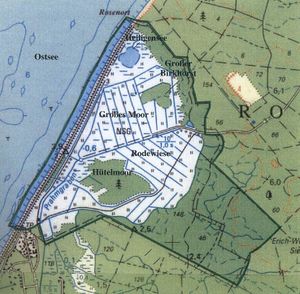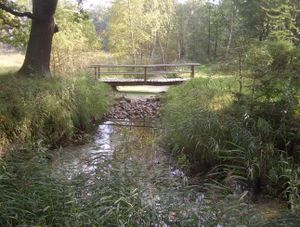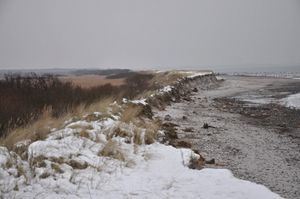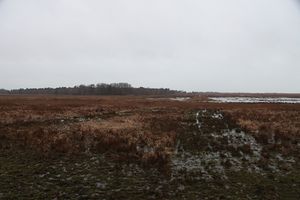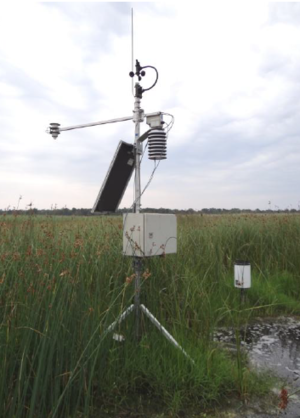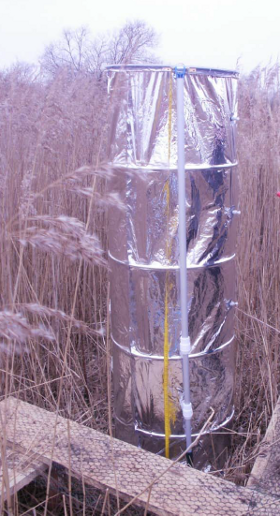Difference between revisions of "Hütelmoor catchment"
| Line 18: | Line 18: | ||
The fen is separated from the Baltic Sea by a dune dike installed in 1963 which increased fresh water supply. The area had been intensively drained for grassland use since the 1970s with water levels down to 1.60 m below ground surface. Therefore, the peat in the upper soil horizons is weakly to strongly decomposed. Peat depths range between 1 and 3 mwith alternating layers of | The fen is separated from the Baltic Sea by a dune dike installed in 1963 which increased fresh water supply. The area had been intensively drained for grassland use since the 1970s with water levels down to 1.60 m below ground surface. Therefore, the peat in the upper soil horizons is weakly to strongly decomposed. Peat depths range between 1 and 3 mwith alternating layers of | ||
sandy sediments as a result of flooding events. For nature protection purposes first restoration measures | sandy sediments as a result of flooding events. For nature protection purposes first restoration measures | ||
| − | were taken in 1992 by closing the main ditch (Schoenfeld-Bockholdt et al. 2005). Almost 20 years later, in 2009 a | + | were taken in 1992 by closing the main ditch (Schoenfeld-Bockholdt et al. 2005). Almost 20 years later, in 2009 a river bed sill was installed to permanently increase the water level to or above ground surface. Since then, the fen is permanently inundated with water levels up to 1.00 m above ground surface. |
== Topography == | == Topography == | ||
Revision as of 15:17, 8 April 2014
Location
In the Rostocker Heide, Mecklenburg-Western Pomerania, Germany
Catchment size
10 km², 54°12′ N, 12°10′ E
Climate
Maritime, anual precipitation 610 mm, anual ETp 640 mm, mean yearly temperature 8.3°C
Geology
Glacifuvial, with intensive peat evolution The fen is separated from the Baltic Sea by a dune dike installed in 1963 which increased fresh water supply. The area had been intensively drained for grassland use since the 1970s with water levels down to 1.60 m below ground surface. Therefore, the peat in the upper soil horizons is weakly to strongly decomposed. Peat depths range between 1 and 3 mwith alternating layers of sandy sediments as a result of flooding events. For nature protection purposes first restoration measures were taken in 1992 by closing the main ditch (Schoenfeld-Bockholdt et al. 2005). Almost 20 years later, in 2009 a river bed sill was installed to permanently increase the water level to or above ground surface. Since then, the fen is permanently inundated with water levels up to 1.00 m above ground surface.
Topography
0-40 m above sea level
Vegetation/Land use
Forest 60 %, pasture 30%, peat 10%
Context of investigation
CH4 emission, salinisation, hydrological processes
Measurements/Equipment
- Meteorological station
- Runoff
- Water level (diver) and runoff
- electrical conductivity (diver)
- soil moisture ( TDR, impedance FDR| Theta porobes , capacitance FDR| 5TE Decagon, TMS - sensor, profile probe )
- CH4 emission, chamber measurment
- Eddi covariance
- water level
- Water level + electric conductivity
Links to project webpages
other Links
- Rostocker Heide at Wikipedia
- Chair for Hydrology and Chair for Landscape Ecology and Site Evaluation University Rostock
References
- Bohne, K., Bohne, B., Prediction of salinization by flooding sandy soils with brackish water, in Fock, T., Hergarden, K., Repasi, D., Salt grasslands and coastal meadows in the Baltic Sea region, PROCEEDINGS OF THE 1ST CONFERENCE, Neubrandenburg, Reihe A: Band 18, 2002.
- Bohne, B., Bohne, K., Monitoring zum Wasserhaushalt einer auf litoralem Versumpfungsmoor gewachsenen Regenmoorkalotte - Beispiel Naturschutzgebiet "Hütelmoor" bei Rostock. In: Stüdemann, O., Aspekte der Geoökologie Weißensee Verlag, Berlin, 2008.
- Koch, S., Jurasinski, G., Koebsch, F., Koch, M., Glatzel, S., Spatial Variability of Annual Estimates of Methane Emissions in a Phragmites Australis (Cav.) Trin ex Steud. Dominated Restored Coastal Brackish Fen, Wetlands, DOI: 10.1007/s13157-014-0528-z, 2014.
- Koebsch, F., Glatzel, S., Jurasinski, G., Vegetation controls methane emissions in a coastal brackish fen, WETLANDS ECOLOGY AND MANAGEMENT 21(5), 323-337, DOI: 10.1007/s11273-013-9304-8, 2013.
- Koebsch, F., Glatzel, S., Hofmann, J., Forbrich, I., Jurasinski, G., CO2 exchange of a temperate fen during the conversion from moderately rewetting to flooding, JOURNAL OF GEOPHYSICAL RESEARCH-BIOGEOSCIENCES 118(2), 940-950, DOI: 10.1002/jgrg.20069, 2013.
- Kolp, O., Die nordöstliche Heide Mecklenburgs. Rostocker Heide, Gelbensander Forst, Forst Alte Heide, Ribnitzer Forst. Geographische Gesellschaft in der Deutschen Demokratischen Republik. Abhandlungen Nr.1 . Berlin, Deutscher Verlag der Wissenschaften, 1957.
- Niedermeyer, R.- O., Lampe, R., Janke, W., Schwarzer, K., Duphorn, K., Kliewe, H., Werner, F., Die deutsche Ostseeküste, 2. Auflage, Gebr. Borntraeger (Stuttgart), Sammlung Geologischer Führer, Band 105, 2011.
